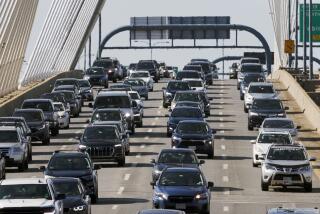Privacy in the car -- at whose expense?
- Share via
I remember a time when if a vehicle with dark tinted windows rolled by, you’d figure the passengers were celebrities, gangsters or politicians.
Today, tinted car windows are so in vogue, you never know if behind those smoky windows is a rapper or a soccer mom.
They are called “privacy windows,” says Steve Mazor of the Auto Club of Southern California.
The question is: “Privacy to do what?”
With so many motorists adding after-market window tints on their vehicles, dark windows have become an automotive fashion trend. It’s a hot seller in the $8.3 billion after-market business, says Peter MacGillivray, marketing vice president at the Specialty Equipment Market Assn.
A big SUV with dark windows may look cool in an MTV music video, but to law-enforcement officers and safety experts, the fad has a dark side of its own. Police and safety advocates say windows dark enough to obscure the driver and occupants pose a threat to law-enforcement officers and can impair driver visibility.
Drivers say they tint their windows to maintain privacy, cut sun and headlight glare and keep their vehicle cool during summer months. But driving with heavily tinted windows “is like driving at night with your sunglasses on,” says Steve Kohler, CHP spokesman. “You don’t want to do that. It limits visibility.”
Mazor agrees that tinted windows can impair driver visibility, particularly at night, making it difficult to see pedestrians and bicyclists, for example.
Light factory-tinted windows that let in 70% of sunlight are legal. But with the exception of multi-passenger vehicles such as limousines, California law prohibits after-market tinting of the front driver’s side and front passenger side windows, as well as windshields.
Last year, the CHP issued a record 82,214 citations against drivers for illegally tinted windows. That’s up 49%, from 55,176 citations issued in 2000, Kohler says.
When police officers make a traffic stop and they can’t see who or what is inside, it can be very threatening, says LAPD officer Kathy Simpson. “They’re in a danger zone ... and they are vulnerable.”
“Officers don’t know if there’s a weapon or a body in the back of the vehicle” in those stops, Kohler says.
Ken Luna of DP Window Tinting in Santa Ana, says his shop will not install heavy black tints on vehicles because “it’s irresponsible.” Nevertheless, he says there are shops that will.
After-market window tinting can cost more than $250.
“People, especially young drivers, think blacking out their windows looks cool,” Luna says. “They don’t understand that people could get hurt.”
Luna, who has 25 years of experience in tinting windows, says, “Instead of seeing a pedestrian clearly through the window, a driver with blacked-out windows, might see only a silhouette.”
In fact, photos in a report last year by the Centre for Automotive Safety Research in Australia showed that a pedestrian seen through heavily tinted windows can barely be seen at night.
The National Highway Traffic Safety Administration has noted that tinted windows can hamper police in determining whether occupants in a vehicle are wearing seat belts or have their children properly protected in car seats.
Tinted windows may also prevent other motorists from viewing the road through other automobiles’ windows -- something that many drivers do, especially when roads are congested with large vehicles.
Jeanne Wright can be reached at jeanrite@aol.com.






